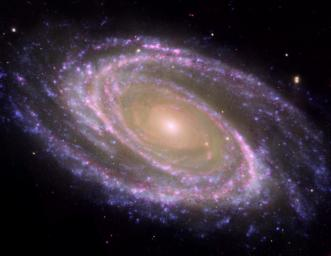11 June 2007

Image Credit:
NASA/JPL-Caltech/ESA/Harvard-Smithsonian CfA
NASA recently published an exquisite image of the nearby spectacular spiral galaxy M81. The image was composed of images acquired by NASA's Hubble Space Telescope, Spitzer Space Telescope and the Galaxy Evolution Explorer (GALEX).
M81 is a wonderful example of a spiral galaxy, with elegant curly arms emanating from its center. It is about 12 million light-years distant in the Ursa Major constellation. Due to its relative proximity and large size, it is one of the brightest galaxies that can be viewed through amateur telescopes.
The colors in this picture code three spectral ranges: blue is ultraviolet emission detected by GALEX; pale yellow is visual light imaged by Hubble; and red is infrared light captured by Spitzer. The ultraviolet is emitted from the hottest, youngest stars, while dust lanes that trace the spiral arms shine in reddish-pink. The core of the galaxy is dominated by red, old stars, characterized by emitting infrared radiation.
Further Reading
The Hubble Space Telescope
http://hubblesite.org/
GALEX
http://www.galex.caltech.edu/
Spitzer Space Telescope
http://www.spitzer.caltech.edu/spitzer/
Aymen Mohamed Ibrahem
Senior Astronomy Specialist